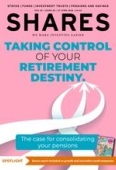Archived article
Please note that tax, investment, pension and ISA rules can change and the information and any views contained in this article may now be inaccurate.
What is pound cost ravaging and how can I guard against it?

I am planning on finishing work in a few months’ time and want to take my tax-free cash from my pension pot. I understand the rest of my pot will remain invested. However, I have been reading up on this and how to manage the investment.
A couple of sources have mentioned ‘pound cost ravaging’. What is this and how can I guard against it?
Dan
Rachel Vahey, AJ Bell Head of Public Policy, says:
Pension savers have a lot of flexibility over how and when they access their pension. One option is to take your tax-free cash and leave the remainder of the pot invested in drawdown. This gives you the freedom to take an income when you want – whether that’s a regular income or one-off withdrawals. Any income taken will be subject to income tax.
If you don’t need to take any income, then leaving it in the drawdown pension may be a good idea. The money continues to invest tax efficiently – no income tax or capital gains tax is due on any investment returns. And any untouched pension pot when you die will usually be sheltered from inheritance tax and can be passed onto loved ones. This could be more tax efficient than taking a regular income, investing it elsewhere, but which may fall into your estate when working out if any inheritance tax is due.
RISKS OF DRAWDOWN
However, drawdown also comes with risks. Let’s say you’re taking large withdrawals in the early years of retirement and your investments suffer big falls - something plenty of people will have experienced over the last 12 months or so. It’s harder to regain the lost ground. This is often called ‘pound-cost ravaging’ and is best demonstrated with an example.
Take two 65-year-olds, Jack and Jane, with pensions each valued at £200,000. Both are taking £15,000 a year out of their pots, rising each year by 2%.
Jack experiences investment returns in the first five years of: -10%, +4%, +4%, +4%, +4%. As a result, his pot is worth just over £125,000 at the end of that period.
Jane, meanwhile, experiences the same returns, but in a different order: +4%, +4%, +4%, +4%, -10%. At the end of the period, her pot is worth almost £135,000.
In other words, simply by experiencing bad investment performance in year one rather than year five, Jack has been left with a pension worth around £10,000 less than Jane. But there may be strategies you can adopt to help guard against these risks.
You could choose to invest some or all your retirement pot into investments that generate an income through dividends. When you take money out of your pension you could be simply withdrawing cash from those dividend payments.
But if not, then you will have to sell down your fund to generate a specific level of income. It can be tricky to decide which investments to cash in, which is why it’s important to do some preparation work before you start taking an income from your pension pot.
CONDUCTING A REVIEW
One tactic could be to review how your investments are performing to decide which ones to cash in. In a rising market this may be straightforward, but in a falling or volatile market this is more difficult.
Another approach could be to lay some groundwork before taking an income and move some funds gradually into cash. For example, you could hold two years’ worth of income as cash and pay an income from that fund, until the market has recovered some ground.
Whatever approach you take, the golden rule is probably only to take as much income as you need from the pension and consider drawing down on other sources of money first, such as ISAs.
DO YOU HAVE A QUESTION ON RETIREMENT ISSUES?
Send an email to askrachel@ajbell.co.uk with the words ‘Retirement question’ in the subject line. We’ll do our best to respond in a future edition of Shares.
Please note, we only provide information and we do not provide financial advice. If you’re unsure please consult a suitably qualified financial adviser. We cannot comment on individual investment portfolios.
Important information:
These articles are provided by Shares magazine which is published by AJ Bell Media, a part of AJ Bell. Shares is not written by AJ Bell.
Shares is provided for your general information and use and is not a personal recommendation to invest. It is not intended to be relied upon by you in making or not making any investment decisions. The investments referred to in these articles will not be suitable for all investors. If in doubt please seek appropriate independent financial advice.
Investors acting on the information in these articles do so at their own risk and AJ Bell Media and its staff do not accept liability for losses suffered by investors as a result of their investment decisions.
 magazine
magazine








